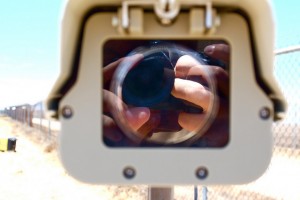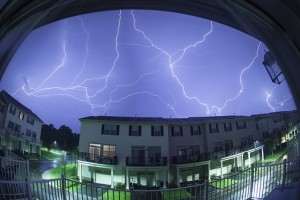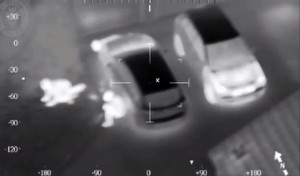 If you have a security system you might already understand the consequences of a false alarm. It is not something to be taken lightly and can have serious implications. False alarms can happen for any number of reasons and it’s important to understand why and how best to avoid them. No security system is perfect, and false alarms are bound to happen, but as end users and integrators it is our duty to try to minimize them. At Perfect Connections, Inc. our licensed integrators have been providing comprehensive security system solutions to businesses throughout northern and central New Jersey since 1992. They are knowledgeable about the products they install and can provide useful information on system function and upkeep to help avoid any mishaps.
If you have a security system you might already understand the consequences of a false alarm. It is not something to be taken lightly and can have serious implications. False alarms can happen for any number of reasons and it’s important to understand why and how best to avoid them. No security system is perfect, and false alarms are bound to happen, but as end users and integrators it is our duty to try to minimize them. At Perfect Connections, Inc. our licensed integrators have been providing comprehensive security system solutions to businesses throughout northern and central New Jersey since 1992. They are knowledgeable about the products they install and can provide useful information on system function and upkeep to help avoid any mishaps.
As technology progresses and advancements in security manufacturing lead to better products it’s likely the instance of a false alarm or dispatch will be lessened. According to Ron Walters, director with the Security Industry Alarm Coalition (SIAC), prior to the 90’s false alarms were typically attributed to faulty security products. Since then manufacturers have been and continue to produce quality products, however that doesn’t guarantee proper application and use. Accurate installation and usage lies the hands of the security integrator and the end user. That is why it is critical to hire a licensed security expert for system installation and user specifications. It is also important that the end user has an understanding of what is expected of them in order to avoid false dispatches. Unfortunately, approximately 15% of false alarms are considered to be caused by user error.
In a world where there are an estimated 35-36 million alarms in use, according to Stan Martin who is the executive director of the SIAC, false alarms are an unavoidable evil. False alarms and dispatches are an annoyance for end users, but their ramifications don’t end there. They take valuable time and resources away from emergency responders that might otherwise be needed at an actual crisis. If you have too many false alarms it can create a “boy cried wolf” situation where authorities might be more hesitant to respond. On top of all that you could end up paying substantial fines for repeat offenses. Recurring false alarms that go unchecked can create tension between local authorities, end users, and security integrators. But negative impacts aside, the SIAC reports that 90% of law enforcement still consider alarm industry professionals valuable allies.
Sometimes it’s difficult to pinpoint the cause of a false alarm as it could have been a situation where an intruder was attempting a break-in and escaped before authorities arrived making it appear like a false alarm. This is where video surveillance, alarm monitoring, and remote system access come in handy. Being able to tap into your facility’s surveillance system and visually verify whether or not an intruder is or was present, is a critical time and resources saver. With remote access via an app on your smartphone or mobile device you can do just that. The beauty of remote access is you don’t have to physically be on site to see what is going on at your facility. Having a monitoring service will also help determine whether or not there is an actual emergency and whether or not authorities should be dispatched. An added benefit to having video surveillance is even if the perpetrator escapes before authorities arrive, the recorded footage can be used to aid an investigation and hopefully identify the intruder.
Aside from having proper security equipment installed there are some helpful tips for end users to keep in mind that will help avoid pesky false alarms. One, always know your alarm code and be sure all windows and doors are secured before arming your system. Two, be sure you get your system tested regularly, it’s typical to have an annual inspection but some situations might require quarterly or more frequent tests. Be sure critical sensors and smoke detectors are adequately covered during any construction or building modification to avoid disruptions caused by debris. Lastly, always consult a licensed security system provider with any maintenance or care questions.
While false alarms aren’t completely avoidable, you can lessen the chances of them happening to you. Hiring a licensed security system integrator who is knowledgeable and has extensive installation experience is key. Installing a comprehensive security system that includes video surveillance, fire and burglar alarms, access control, and a monitoring service will provide complete coverage and reduce the risk of false dispatches and alarms. At Perfect Connections, Inc. our licensed professionals have been providing comprehensive security systems to businesses throughout northern and central New Jersey for the past 23 years. Our technicians have the experience and expertise to install security devices and can help educate you on proper usage.
If you live or run a business in Central or Northern New Jersey and would like information on any of the topics discussed above, please call 800-369-3962 or simply CLICK HERE.
Image Credit: Image by Shannon Clark-Flickr-Creative Commons
 The images above show the difference between a parking garage being monitored by a camera with no WDR or WDR turned off on the left, and on the right the same area monitored by a camera with WDR enabled. The difference is clear as day. Why do they differ so much? The camera with the WDR enabled has two internal Charge-Coupled Devices (CCD). The two devices, or sensors, scan an image at different speeds, one low and one high, the image processor then combines the separate images producing a clearer, more balanced picture with better contrast and lighting. This process happens quickly enough to produce a stream of clear recorded footage. There are many different manufacturers that produce these WDR cameras in the market today, and not all of them use the same type of sensor and image processing combinations. The best way to ensure you are getting the best camera for your specific application is to hire a licensed security systems integrator who is educated in which camera specifications will work best in variant conditions.
The images above show the difference between a parking garage being monitored by a camera with no WDR or WDR turned off on the left, and on the right the same area monitored by a camera with WDR enabled. The difference is clear as day. Why do they differ so much? The camera with the WDR enabled has two internal Charge-Coupled Devices (CCD). The two devices, or sensors, scan an image at different speeds, one low and one high, the image processor then combines the separate images producing a clearer, more balanced picture with better contrast and lighting. This process happens quickly enough to produce a stream of clear recorded footage. There are many different manufacturers that produce these WDR cameras in the market today, and not all of them use the same type of sensor and image processing combinations. The best way to ensure you are getting the best camera for your specific application is to hire a licensed security systems integrator who is educated in which camera specifications will work best in variant conditions. When it comes to security systems you may have heard the term “edge technology,” “edge analytics,” or “edge devices.” What exactly do these terms mean and why are they important? When talking about security systems “the edge” is typically used when referring to video surveillance components. Every security system integrator and industry professional will likely have their own definition of what it means, but in summary “edge technology” refers to surveillance devices that operate, analyze, and record at their source versus transmitting all that information over a network to the system’s core. In traditional surveillance systems there is a central server where recorded data from peripheral devices is stored and analyzed. In an edge-based system cameras perform these functions locally.
When it comes to security systems you may have heard the term “edge technology,” “edge analytics,” or “edge devices.” What exactly do these terms mean and why are they important? When talking about security systems “the edge” is typically used when referring to video surveillance components. Every security system integrator and industry professional will likely have their own definition of what it means, but in summary “edge technology” refers to surveillance devices that operate, analyze, and record at their source versus transmitting all that information over a network to the system’s core. In traditional surveillance systems there is a central server where recorded data from peripheral devices is stored and analyzed. In an edge-based system cameras perform these functions locally. What is it about our homes that make us feel safe? Is it the sound of our kids running up and down the stairs? Is it the personalized décor? Is it the smell? Maybe it’s the locks on our doors and windows or the surrounding neighborhood? Whatever it is, we all want that feeling to last, right? Of course we do. So what are you doing to maintain the safety and security of your home? There are many tips and tricks you can use to safeguard your home, one of the best defenses is a customized comprehensive security system. As a trusted security systems provider for the past 23 years, our team at
What is it about our homes that make us feel safe? Is it the sound of our kids running up and down the stairs? Is it the personalized décor? Is it the smell? Maybe it’s the locks on our doors and windows or the surrounding neighborhood? Whatever it is, we all want that feeling to last, right? Of course we do. So what are you doing to maintain the safety and security of your home? There are many tips and tricks you can use to safeguard your home, one of the best defenses is a customized comprehensive security system. As a trusted security systems provider for the past 23 years, our team at  We all know the weather is unpredictable no matter how many radars or meteorologists tell us otherwise. Mother Nature is impulsive and she strikes at will. A common and sometimes unpleasant result of severe weather is power outages. During a thunderstorm outages may last a couple of hours but extreme weather conditions have been known to leave civilians without power for weeks at a time. The
We all know the weather is unpredictable no matter how many radars or meteorologists tell us otherwise. Mother Nature is impulsive and she strikes at will. A common and sometimes unpleasant result of severe weather is power outages. During a thunderstorm outages may last a couple of hours but extreme weather conditions have been known to leave civilians without power for weeks at a time. The  House fires. Nobody wants to think about them, but they are an unfortunate reality in our imperfect world. While a house fire can be unpredictable there are precautionary measures you can take to avoid them. Being prepared is half the battle, but knowing what to do in the event of a fire is equally important.
House fires. Nobody wants to think about them, but they are an unfortunate reality in our imperfect world. While a house fire can be unpredictable there are precautionary measures you can take to avoid them. Being prepared is half the battle, but knowing what to do in the event of a fire is equally important. Not all surveillance cameras are created equally. It may seem as simple as selecting a surveillance camera and popping it into place, but what about the external factors that affect the quality of recorded images? One of the top concerns for industry professionals and end-users alike is a cameras ability to function in the dark or varied light conditions. Whether you’re using interior or external cameras, their ability to function under varied light conditions is paramount. Our experts at
Not all surveillance cameras are created equally. It may seem as simple as selecting a surveillance camera and popping it into place, but what about the external factors that affect the quality of recorded images? One of the top concerns for industry professionals and end-users alike is a cameras ability to function in the dark or varied light conditions. Whether you’re using interior or external cameras, their ability to function under varied light conditions is paramount. Our experts at  In an unpredictable world, one thing is certain, we all want to protect what’s ours. Whether you’re a business owner or a homeowner, you want to keep safe that which you’ve worked so hard for. One of the most effective ways to do that is to install a security system. Well, what exactly is a security system and what makes it a complete security system?
In an unpredictable world, one thing is certain, we all want to protect what’s ours. Whether you’re a business owner or a homeowner, you want to keep safe that which you’ve worked so hard for. One of the most effective ways to do that is to install a security system. Well, what exactly is a security system and what makes it a complete security system?  When you picture a surveillance monitoring station what do you see? Is it a half awake guard staring blankly at multiple monitors? If that’s the case you can scratch that image from your mind. The future of monitoring services is quickly shifting and adapting to our society’s need for streamlined and efficient processes. As surveillance systems migrate from analog to IP with megapixel network cameras, and our world becomes more and more connected through the IoT (Internet of Things), the desire to access and monitor footage from anywhere increases. This is where the idea of remote monitoring comes into play.
When you picture a surveillance monitoring station what do you see? Is it a half awake guard staring blankly at multiple monitors? If that’s the case you can scratch that image from your mind. The future of monitoring services is quickly shifting and adapting to our society’s need for streamlined and efficient processes. As surveillance systems migrate from analog to IP with megapixel network cameras, and our world becomes more and more connected through the IoT (Internet of Things), the desire to access and monitor footage from anywhere increases. This is where the idea of remote monitoring comes into play.